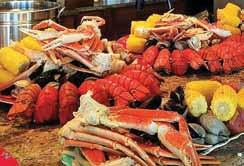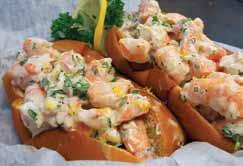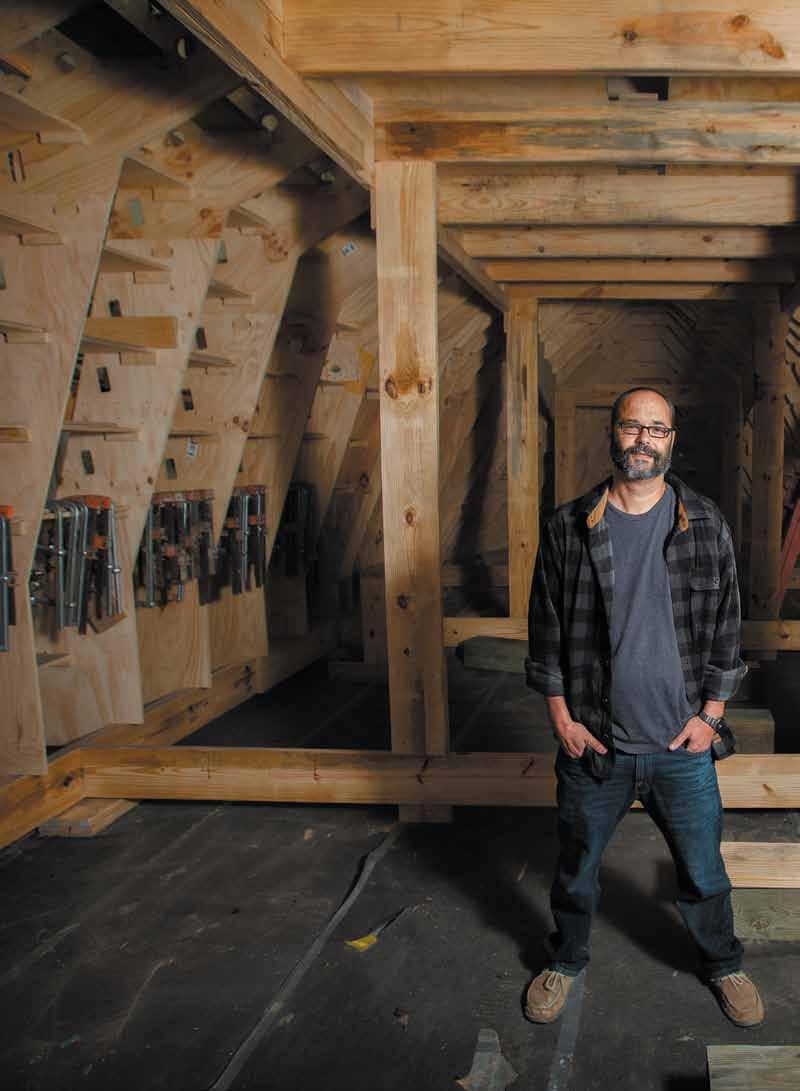
18 minute read
Wanchese Calling
CLAM BAKES
SANDWICHES
Advertisement



BREAKFAST BURRITOS

CATERING

Breakfast, Lunch, Prepared Meals, Fresh Roasted Coffee & Espresso, Wedding & Personal Chef Services
MP 8.8 on the Beach Road, KDH
252-441-9607
Tenosixobx.com
wanchese calling
Drawing plans. Glassing decks. Sealing interiors. Hauling it all. Not everyone who works in a boatyard gets their name on the hull. Here’s a look at four compelling trades and personalities keeping the Outer Banks’ original essential business afloat.
Profiles by M. Leigh Ward Portraits by Chris Bickford
wanchese calling THE DESIGNER
EvEry Bayliss drEamBoat starts with a sEt of PEtE BuEschEr Plans.
Pete Buescher didn’t set out to work in the sportfishing boat
industry. But he feels damn lucky to have landed in the thick of it. As design manager at Bayliss Boatworks, he is responsible for helping dream up some of the most renowned custom yachts in the world. Not that landing in Wanchese was his original vision. “Fate and time just ended up leading me here,” Buescher says. “But boats have always been intriguing to me, because they are functional pieces of art.” Growing up in Virginia Beach, Buescher developed an appreciation for small, wooden watercraft, like speedboats and runabouts. When he was 15, he built his own 15-foot rowboat/sailboat in the stitch-and-glue method. Knowing he wanted a career in boats in some capacity, and that a career in small wooden boats wasn’t necessarily one to bank on, he headed off to Virginia Tech to major in industrial design, which he describes as a hybrid of product design and architecture. He even stayed on to get a second degree in ocean engineering. But at most naval architecture schools, the focus was on huge, slow boats, like Navy ships, barges and tankers — not elegantly designed wooden or recreational vessels. And certainly not the ones built for speed. “Everything I’ve learned about fast boats I’ve learned not through school but through my bosses,” Buescher says. “I’ve worked three places, and I’ve had three amazing, hall-of-fame-style bosses.” It began during college summers and on winter breaks, when he worked as an intern at a wooden boatyard in Maryland and learned about cruising boats. After finishing his degrees, he got a job with DLBA Naval Architects in Chesapeake, where he spent 15 years. In 2018, John Bayliss lured Buescher to Wanchese to design his sportfishing yachts in-house and full-time — the Outer Banks’ only full-time naval architect, as far as Buescher knows. It’s more than imagining big ideas. Buescher works directly with clients, owners and captains alike, to fit their wants and needs into a boat that runs efficiently, functions well, looks good, and meets the Bayliss standards — without letting them totally lose the plot. “With custom boats, there are limitless options,” Buescher says. “But we reign them in.” Thus begins the “design spiral,” and the creation of the specifications document that drives the build. Throughout the project, Buescher communicates with the office staff and workforce to make sure that what’s on paper ends up on the boats. Design and its implementation, and frequent changes, continue throughout the life of the build. And with several builds going on at one time — usually around three or four in the active build stage, three or four in the design process, and a few potential clients — Buescher is constantly busy. He says the Bayliss company culture of always improving and striving for perfection makes his job “consuming.” “You can’t stop thinking about this stuff,” he says. “There are so many things to get right. Every decision creates a cascade of effects throughout the boat, and that keeps us thinking all the time.” Buescher does most of his work using computeraided design (CAD), but prefers drawing by hand. Even now, sketching is one of his main ways of sharing ideas, which is why he carries around a little black notebook that expresses his thoughts on even the minutest details.
“But I’m not really drawing boats by hand anymore,” he says. “We’ve gotten so good and efficient at developing them on the computer.” When not staring at a screen, Buescher checks on all the builds in the shop each day, carrying his notebook of ideas and mockups with him. From then on, it’s usually solving problems and putting out fires. Designing, he says, is the easy part of his job. Working with various personalities and keeping all the people happy is the part that creates the most challenges. While, professionally, Buescher enjoys working on luxury yachts, personally he’s still hung up on those small wooden boats. At home, he’s currently building a 25’ runabout, a small, elegant little piece of art that’s all pleasure — and no work. Well, maybe a bit of both. “It’s a lucky thing for people to know at a young age what they want to do,” he says. “Of those who know what they want to do, there are very few who are actually lucky enough to be doing it. It has worked out well for me.”
THE CARPENTER
whEthEr laying fiBErglass — or trading BantEr — maggiE ingram fEEls right at homE in wanchEsE.
Young and beautiful. With long, black braids trailing down the front of her slicker, Maggie Ingram might be the last person you’d expect to find in the trenches of a custom boat shop. Until you see her at work, building bulkheads, laying fiberglass, and swapping barbs with her band of “brothers.”
“Don’t make this photo look too pretty,” laughs the lively 23-year-old, pulling screws at blazing speeds. “I’ll never hear the end of it.” For the past three years, Ingram’s been a key part of Harrison Boatworks’ crew. But her path to Wanchese began six years ago. All the way back in high school — and far up in Mystic, Connecticut — where she stumbled into the oddest of after-school jobs: doing varnish and paint work on lobster boats for a man named Tom Townsend. “I had to force myself to be good at school,” Ingram says. “I got good grades because I tried really hard, but it didn’t come naturally to me to be book smart. What did come natural was being good with my hands.” After graduation, Townsend recommended to Ingram that, instead of a four-year college, she should head to The Landing School in Arundel, Maine, to study boatbuilding. In 2015, she enrolled — one of two women in a school of around 80 students. But, the learning curve proved to be a larger shock than the male-to-female ratio. “I grew up on the water in a boat-centric town,“ she explains. “But I was ignorant to the nuances of boats. And I didn’t even know how to use tools. I was thrown into the water. I had to learn everything, and everything hit me at once. “I remember thinking, I really don’t know if this is a good decision,” she continues. “But it ended up being the right one.” All that doubt ended her first year, when her team built a 12’ flat-bottomed skiff known as a Yankee tender, as well as an Arundel 19’. “For someone like me, who gets a great deal of satisfaction from seeing something through from start to finish, it was awesome to see it completed,” Ingram says. She spent one more year taking the marine systems curriculum before heading back to work on the lobster boats. Soon after, a former schoolmate convinced her to come to Wanchese to do the paint and varnish work for Harrison Boatworks. By the time she arrived, her friend had moved away temporarily, so at 19 Ingram found herself in a little village where she knew no one — and the boat she planned to live on cold and crawling with roaches. “It was scary,” she admits. But it wasn’t long before she found a new house to settle into and discovered warm, adopted family on the job. “I feel like I’m part of something,” she says. “Part of a team.” At a small shop like Harrison’s, everyone does a little bit of everything, and every project comes with some new responsibility. In her fourth year now, Ingram mainly works on the hulls just after they are flipped, building and installing bulkheads, putting in decks, installing structural foam, side sealing, and fiberglassing — but she might also be found painting or prepping, cleaning the shop, fixing rot, eyeballing and taping waterlines — or one of many other tasks. “I love getting really good at what I’m being asked to do,” she says. She also does paint and varnish work for other boat shops. Not once does she worry about working in an all-male industry. “I feel like I’m goofing off and getting mad at my brothers all day,” she says. “I have two brothers at home. Now I have eight.” Off the job? People’s reactions vary to her choice of careers. Guys tend to be more excited and consider it “cool.” Women aren’t sure what to think. Her high school drama teacher flat out told her she was disappointed. “A lot of people don’t want to do manual labor, but I’m all about it,” Ingram says. “I don’t want to sit at a desk all day. I might think differently in 20 or 30 years, though.” Adding to her enthusiasm is that she just learned from her phone that she walks at least five miles every shift. But, more importantly, she says, her parents are super proud of her. “I know they miss me, but I think they are really happy for me.” Ingram also applies her skills to her personal life. She built all the furniture in her house in Columbia, from the couch to the kitchen island to the closet shelves.
“Everything adds up, and you can apply it somewhere else,” she says. In her free time, she practices wood burning, which she taught herself after a breakup and before she’d met many friends in town. Working on any piece of lumber she could find, she created art out of an open garage in Wanchese. People began stopping in to see what she was doing, then they started commissioning her for projects and gifts — everything from business logos to fish, boats and scenery. All images and experiences inspired by her coastal roots and an old fishing town near Mystic, called Noank. “I think my biggest attraction to Wanchese is how tightly knit everybody is,” she says. “My favorite part is driving through town, and anybody who has seen me even remotely will wave as they’re driving by. That’s a huge deal to a New Englander. Where I’m from, nobody even says hi. Here, everyone welcomes you with open arms.”
THE PAINTER
sErgio carrillo Pours his hEart into EvEry joB — and aPPliEs himsElf to EvEry task.
He came here as an electrician who didn’t speak English. Two decades later, he’s the lead painter on one of the largest and most unusual boat projects to ever be undertaken in Wanchese. That’s the story of Sergio Carrillo, who succeeds by paying close attention to the task at hand — and applying high standards to every job. “What I did is always watch what others were doing,” says the 45-year-old Peruvian native, “and try to do better.” Carrillo first arrived to the Outer Banks in 2000. The former factory electrician followed his aunt and uncle here, lured by a promise of more reliable, and more lucrative, work. He soon had two jobs: by day, block-sanding hulls at Davis Boatworks for $7 an hour, and, by night, washing dishes at Lone Cedar Café. After a couple of months, he found a slightly better paying job at Paul Mann Custom Boats in Manns Harbor, but not speaking English made advancing in any shop nearly impossible. “There are lots of guys I know who’ve been here a long time and don’t speak the language,” he says. “It builds a wall.” Carrillo knew to keep climbing the ladder, he first had to break down that wall. He tried taking traditional English classes, but that proved difficult. Instead, he turned to movies. With the sound in English and the subtitles in Spanish, he slowly taught himself, repeating lines from the movie aloud, then practicing applicable sentences with his uncle and the American guys on the job. “It was hard, but you have to go through that,” he says. Carrillo soon found more success. At home, he settled into family life with his wife. And at work, he found his big break when he joined Bayliss Boatworks, just as the sportfishing yacht leader was finishing up its first hull. Carrillo did what he was asked to do — a little of everything at first — and put his heart and sweat into every task. “One thing I’ve learned is that sometimes people just work for the money,” he says. “They’ll make something take all day because they are working by the hour. This is not the way. I never asked for a raise, but I always got one because I always did a good job.” Carrillo ended up staying at Bayliss for 15 years, eight of those as the righthand man for paint supervisor Brett Smith, learning the basics of paint prep, painting and top-coating, but also the essential yet complex skill of fairing — the process of streamlining a hull by removing highs and lows on the surface before applying primer and paint. Carrillo excelled not just because he’s good at it, but because he enjoys it. “I love the satisfaction of doing a good job,” he says. “What I like is when the owners see the finished project and they say ‘Wow!’ I’ve seen owners so proud. I’ve seen owners cry they were so happy. So that’s my motivation.” Eventually, Carrillo left Bayliss to work for Smith at Global Yacht Coatings, where he spent three years traveling the East Coast, painting hulls and burnishing his reputation for quality with every assignment. So, when Felix Herrin was looking for a lead paint manager for his new H2 Project, Carrillo was an obvious choice. “We were looking for the brightest and the best for a project of this caliber, not just bodies to fill positions,” Herrin says. “So we targeted Sergio to lead our paint crew.” Now Carrillo has a crew of four or five guys working for him. He spends his days in a full face respirator, spray suit and gloves, sanding, varnishing, fairing, spraying, top-coating, or doing whatever needs to be done on a 110-foot powerboat — one of the largest ever built locally (with the exception of military patrol boats built here during World War II). Adding to the complexity of fairing and painting on the H2 Project is the fact that the boat is constructed of aluminum. In all, the project includes approximately 18,000 square feet of surface area. “It’s a cool project, I really love what I do,” Carrillo says. “It’s a lot of work, but it gives me opportunity to help others. I pay well and they come happily to work for me.” He doesn’t just cut bigger checks. Carrillo takes time to teach his crew new skills, the same way Bayliss, Smith and other coworkers mentored him.
“I always try to teach,” he says. “Some don’t want to teach because they think someone will take their job, but that’s not me.” It’s that generous spirit that’s allowed Carrillo to build such a productive life here in North Carolina. Twenty years later, he and his wife now have two teenagers. He’s found a spiritual family at the Ark Church, and made a lot of good friends. Now he’s the one helping newcomers find employment and translating for non-English speakers. In each case, his main message is to find joy in your work. “Guys will tell me they’re not happy where they’re at,” he says. “I say, if you don’t love what you’re doing, you’re in the wrong place, you’re doing the wrong thing. One of my cousins told me, ‘I’m going to be happy five years from now when I make $30 per hour.’ I say if you’re not happy now, then you’re not going to be happy then. You have to do what you do with love.”
THE “On my 18th birthday, I got my commercial driver’s license so I could drive the trucks,” Luke says. Not long after, Meekins was running the show with his dad’s help. Eight years ago, Meekins legally purchased the operation at the tender age of 24. Even today, wizened
MOVER boat owners might be taken aback to see a relative whippersnapper pull up to flip or move their most precious possessions. But the local work crews were never concerned. “Everybody trusts him to do it, because he’s been doing it so long,” says Harrison. And he does it well, pouring his heart into every aspect of the job. When Luke took over, SouthSide Services had one truck and two boat trailers. Now it has five trucks, six trailers, two crane trucks, a forklift, and a dump trailer. BEtwEEn thE yard and thE watEr liEs a cranE, a trailEr — and lukE mEEkins. “When Dad had it, it was somewhere between a hobby and a business,” Meekins beams. “Dad said I made it a real business.” Another way SouthSide Services has grown is by adapting to the ever-changing needs of the market. When Gunboat was building sailing catamarans in Wanchese, Luke and Lish designed and built a new trailer for launching the massive cats. Now that Gunboat is gone, SouthSide Services uses that trailer to help out Croswait Composites. “We find a need and design something to fill it,” Meekins says. “We call ourselves practical engineers. We just evolve with everything.” Meekins’ favorite of their inventions is a hybrid military truck and salvaged crane that Lish sketched and designed in chalk on a metal table. “We took the crane part off, cut the army truck in half, put them together, and made an army truck crane — and it works,” Meekins says. “That took eight months to build, and we’ve had if for five years. I’m really proud of that truck.” Among other things, they use the truck to flip boats from keel-up to keel-down. And when Meekins isn’t moving tonnage, he’s pushing paper — pulling permits for every job and dealing with insurance, billing, invoicing, scheduling, payments, inspections, and keeping his wide-load escorts certified. “I work reverse banker hours: five to nine, sunup to sundown,” he says. “Saturday is for personal stuff, and every Sunday I rest and spend time with family.” What he likes about the job is that it’s different every day. “There is a challenge onsite every time,” he says. “We get stuck in the mud, there’s a tree in the way, a powerline needs to be moved. But you can’t let it bother you. You just have to adapt and overcome. And we enjoy a challenge.” Lish passed away in 2018, so now it’s just Luke running the business, looking more and more like his dad every day, with his thick, black beard and friendly demeanor. He also keeps adding more aspects to the business — marine and otherwise. He salvages boats that wash ashore, demolishes derelict boats, and transports houses, planes, automobiles — whatever needs moving or removing. And he keeps building and maintaining the fleet of vehicles with the help of Jay Hooper, a retired machinist. At last count, between his business vehicles, personal vehicles, and recreational vehicles, like motorcycles and four-wheelers, Meekins says he has 178 tires on the road. “I’ve always been passionate about mechanic work,” he says. “It started off with small toys, like four-wheelers and golf carts, and progressed. I just get it. I most recently bought a large forklift, so I’m studying that machine and how it works and what I can do with it. At night, my wife reads books, and I read parts manuals.”
Might be after the hull is complete. Or before the engine’s ready to go on. But when the heavy lifting begins, they all call Luke Meekins. With a stockpile of military trucks, trailers, cranes, and forklifts, the 32-year-old Wanchese native can move boats, install towers and engines, or flip cold-molded boats from keel-up to keel-down. All told, Meekins has personally handled hundreds of millions of dollars in maritime vessels. And for one good reason. “He’s comfortable working with enormous, expensive objects,” says Patrick Harrison of Harrison Boatworks. “He knows how to lift them, but more importantly, he knows the limitations of his equipment.” Luke’s father, the legendary Ulysses “Lish” Meekins, started the business — SouthSide Services and Towing — back in the mid1980s, and it has since launched nearly every boat built in Dare County. Lish — whose Roanoke Island roots date back almost three centuries — recognized a boat-moving niche that needed filling when, after high school in the 1970s, he started working at the “railway” at Wanchese harbor. The railway was the place where commercial and recreational boats would be winched to and from the water for repairs, but getting the vessels to and from the ramp required calling and waiting on an out-of-town boat mover. Lish learned how to weld, then built a trailer of his own design that could move boats from yards and shops to the boat ramp. Renowned builders Warren O’Neal and Buddy Cannady were some of his first customers. And before long, every boatbuilder, as well as captains from across Dare County, were requiring Lish’s services. In the early days, 50-foot boats were considered big, but over the years the boats got bigger (70 then 80 and 90 feet), so Lish hand-built bigger trailers to do the work. He also hired some fresh help from in-house. “I started riding shotgun in the tow truck with dad when I was eight years old,” says Luke. “I got paid $20 a day to get him stuff and run the hydraulic lever.” It was only supposed to be a Saturday gig. Later, a part-time job. In fact, when Luke graduated from Manteo High School, he made plans to sign up for the Coast Guard, following in the steps of both of his grandfathers. But when Lish was diagnosed with cancer and needed a stem cell transplant, he asked Luke to stay home for a while longer and help him with the business.




